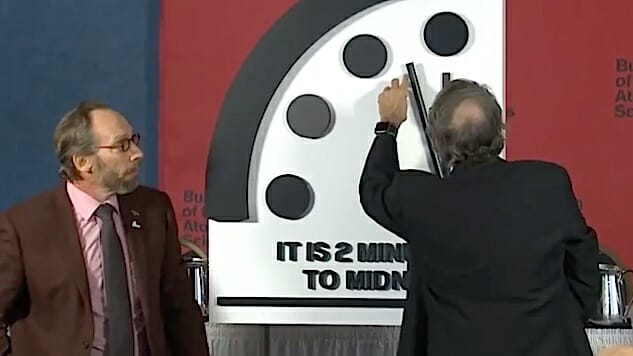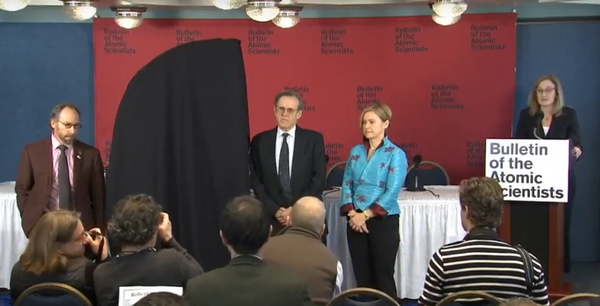
I saw this tweet in my feed this morning, and I’m ashamed to admit that a slight fearful frisson lit up my nerve endings:
BREAKING: Doomsday Clock signalling how close Earth is to destruction has been set at two minutes to midnight, the most dire reading since 1953. Trump’s nuclear bravado and world’s inaction on climate change blamed: https://t.co/kOFWUl34LM
— CBC News Alerts (@CBCAlerts) January 25, 2018
TWO MINUTES TO MIDNIGHT! WE’RE ALL GOING TO DIE, AND I HAVEN’T EVEN TRIED ANY SERIOUS DRUGS!!!
Once I settled down, I asked myself a question—what is the Doomsday Clock, really? I did some research, and I’m ready to pronounce my conclusion: The Doomsday Clock is stupid.
Now, this isn’t meant to make light of the serious problems in the world. Global warming is a living nightmare, and barring some miracle of good sense and civic responsibility that appears impossible, we actually are all going to die. It might be a long way off, but in the meantime we’ll see an increase in famine, disease, warfare, displacement, etc. “Hell on Earth” is slowly becoming a reality, and if you’re looking for a good scare, read this. And though I agree with Roger Sollenberger that Trump isn’t actually going to drop a nuke on North Korea, I also shudder to see each new bombastic tweet, and I deeply wish this doddering imbecile were not in charge of the nuclear arsenal. So please don’t take this post as minimizing the very real issues we face as a species. I just want to make fun of a stupid clock.
Because the Doomsday Clock? My friends, the Doomsday Clock is dumb as hell. It plays off our very real fears in an attempt go gin up attention for a “device” that has no inherent scientific value.
Here’s a little background, Wikipedia style:
The Doomsday Clock is a symbol which represents the likelihood of a man-made global catastrophe. Maintained since 1947 by the members of the Bulletin of the Atomic Scientists’ Science and Security Board, the Clock represents an analogy for the threat of global nuclear war. Since 2007, it has also reflected climate change and new developments in the life sciences and technology that could inflict irrevocable harm to humanity.
The Clock represents the hypothetical global catastrophe as “midnight” and The Bulletin’s opinion on how close the world is to a global catastrophe as a number of “minutes” to midnight. Its original setting in 1947 was seven minutes to midnight. It has been set backward and forward 22 times since then, the smallest-ever number of minutes to midnight being two (in 1953 and 2018) and the largest seventeen (in 1991).
In other words, for 70 years a group of people have been fiddling with a meaningless “clock” to guess how close we are to annihilating ourselves. Two minutes to midnight, our current setting, is tied for the worst ever—worse even than the Cuban Missile Crisis in 1962, which is indisputably the closest the world has ever come to large-scale nuclear warfare. (They missed their big chance because they couldn’t hold a meeting on time.)
The Bulletin‘s Science and Security board meet twice a year to “discuss events” and decide if they’re going to change the clock, and they’ve opted to do so 22 times since the clock was invented in 1947.
Before I get into why the Doomsday Clock is essentially pretty stupid, I want to issue a caveat—insofar as it scares the hell out of people and raises awareness about important issues, the clock could be useful, even if it’s also ridiculous on a fundamental level. I actually don’t believe that there are many people who suddenly start caring about nuclear war and climate change because of a fake clock, but whatever.
Now, back to the clock-bashing. If you want proof that the Doomsday Clock has been both arbitrary and attention-hungry since day one, check out the story of its invention, from the website’s FAQ:
Who created the Doomsday Clock?
Co-editor Hyman Goldsmith asked artist Martyl Langsdorf to come up with a design for the cover of the June 1947 edition of the Bulletin, the first issue published as a magazine rather than a newsletter. Martyl—as she was known professionally—was married to a physicist, Alexander Langsdorf, who worked on the Manhattan Project while at the University of Chicago.
At first the artist considered using the symbol for uranium. But as she listened to the scientists who had worked on the Bomb, as they passionately debated the consequences of the new technology and their responsibility to inform the public, she felt their sense of urgency. So she sketched a clock to suggest that we didn’t have much time left to get atomic weapons under control.
It was an artist! This idea that is supposed to scare the bejesus out of us came about because an artist who uses a mononym, like Cher or Madonna, thought a uranium symbol would be too boring!
And this detail is so amazingly idiotic:
What time was displayed on the original Doomsday Clock?
Martyl set the original Clock at seven minutes to midnight because, she said, “it looked good to my eye.”
“How should we decide the original basis on which we predict the imminence of all future global catastrophes?”
“Ehh, just let the illustrator decide what looks coolest.”
Decisions about changing the clock were made by one guy up until 1973, and are now made by the magazine’s board. They seem like smart people who know their shit, but dig the self-importance of the announcement:
“It is with considerable concern that we set the Doomsday Clock, as of today,” Rachel Bronson, president and CEO of the organization, said during a news conference. “It is two minutes to midnight.”
Here’s my big beef: IT DOESN’T MEAN ANYTHING. There is no concrete foundation from which we can derive any real significance from this absurd fictional clock.
“Two minutes to midnight” is a pronouncement that is utterly without real context. Last year it was two-and-a-half minutes to midnight, and now we’re 30 seconds closer…but what the hell is that supposed to indicate? There are 86,400 seconds in a day, which means that 30 seconds represents a .03 percent increase—are they trying to say we’re in .03 percent more danger than last year? And that if Trump stops tweeting threats at Kim Jong-Un, we’ll be like, .56 percent safer next year?
The CBC describes the clock as a “metaphor,” but it’s a pretty bad one. I mean, look at this guy:
Doomsday Clock moves up 30 seconds — the closest it’s been to midnight in 60 years https://t.co/fXTWoAi8d4pic.twitter.com/mMvqLA6N91
— The Hill (@thehill) January 25, 2018
That man is a brilliant scientist (I presume). Doesn’t he feel like an idiot moving a hand on a giant clock?
Or hell, look at this still from the event:
They had the doomsday clock hidden behind a black cloth so they could do a big reveal! Actual journalists showed up to cover it!
Now watch the video of the critical moment, and try to keep a straight face…and keep in mind that this is not a Christopher Guest film:
I can’t tell which is funner—the awkward mid-sentence pause to cue the two dudes, the struggle to remove the cloth, or the slight awkward push of the minute hand. What if he had accidentally sent it spinning past midnight. Folk, you would not be reading these words right now.
Look, we should all be terrified, and we should all be working to change our broken world. But I can’t take the Doomsday Clock seriously, even for a moment. It has no actual bearing on the nearness of the apocalypse, and the reference point for any modern adjustment is an artistic whim that is now 70 years old. Science is important, but it should also be precise. This is pseudoscience dressed up in a package of performative fear, and the only response it merits is a laugh.
